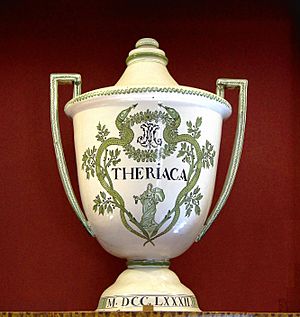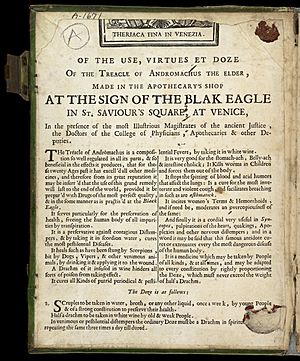Theriac facts for kids

Theriac (pronounced THEER-ee-ak) was a very old and special medicine. People in Ancient Greece first made it around 2,000 years ago. It was thought to be a powerful antidote (a medicine that fights poison) and even a cure-all for many sicknesses. Theriac became popular across the ancient world, reaching places like Persia, China, and India through the Silk Route trade paths.
The name theriac comes from a Greek word, thēriakē, which means "about animals." This is because it was often used to treat bites from dangerous animals. In the past, people believed that a small amount of a harmful substance could help fight a bigger problem, like using a tiny bit of snake venom to cure a snake bite. This idea was sometimes called "the hair of the dog" principle. For example, some thought that if theriac contained parts of a snake, it could fight snake venom.
Some people, like Henry of Grosmont, 1st Duke of Lancaster, even thought theriac could help with "poisonous sin" in a person's soul. During times of terrible sickness like the Black Death, which many believed was a punishment from God, theriac was seen as a very important medicine. However, some experts today believe theriac actually helped with pain, coughing, and diarrhea.
History of Theriac
The story of theriac often starts with King Mithridates VI of Pontus. Legends say he experimented with poisons and their cures on prisoners. He claimed to have found an antidote for every poison. He mixed all these cures into one medicine called mithridatium. This mix had ingredients like myrrh, saffron, ginger, cinnamon, and castor, plus about forty other things.
When the Romans defeated King Mithridates, they found his medical notes. Roman doctors then started using his ideas. Andromachus, who was Emperor Nero's doctor, made mithridate even better. He increased the ingredients to sixty-four, adding viper's flesh. This snake part, after being roasted and aged, became a key ingredient in theriac. Some historians also think theriac might have come from an ancient Egyptian recipe called kyphi.
The famous Greek doctor Galen wrote a whole book about theriac. One of his patients, the Roman emperor Marcus Aurelius, took theriac regularly.
In the year 667, visitors from Rûm brought theriac to Emperor Gaozong in China. The Chinese noticed it was dark red and contained gall from swine. The Chinese expert Su Kung wrote that it was helpful against "the hundred ailments." In the Middle East, theriac was known as Tiryaq.
During the Middle Ages in London, theriac arrived on ships from the Mediterranean Sea. It was very expensive and often called Venice treacle by English apothecaries.
When the Black Death spread in the mid-1300s, a doctor named Gentile da Foligno suggested using theriac that was at least a year old. He thought children should not eat it but could have it rubbed on their skin as a salve.
In 1669, a French apothecary named Moyse Charas shared the secret recipe for theriac. This helped break the control that Venice had over making and selling this important medicine.
How Theriac Was Made
Making real theriac was a very long process. It took many months to gather all the different herbs and other ingredients. Then, these ingredients had to go through a process called fermentation. After that, the mixture was supposed to age for several years. Because of all this work and time, theriac was very expensive. Only wealthy people could afford it.
According to an old Jewish scholar named Moses ben Nachman, some ingredients of theriac included leaven, honey, parts of wild animals and reptiles, dried scorpion, and viper.
Galen believed that theriac was most powerful six years after it was made. He also thought it could stay effective for up to 40 years! Because of this, people would often make very large amounts at once. For example, in 1712, about 150 kilograms (330 pounds) of theriac were made in one go in Maastricht, Netherlands.
By the time of the Renaissance (a period of great change in Europe), making theriac had become a special public event, especially in Italy. Pharmacists continued to sell theriac as late as 1884.
Venice Treacle: A Special Theriac
One famous type of theriac was called Theriaca andromachi or Venice Treacle. This version had 64 different ingredients. Besides viper flesh, it included cinnamon, agarics (a type of mushroom), and gum arabic. All these ingredients were ground into a powder and then mixed with honey to make a thick paste, called an electuary.
See also
 In Spanish: Triaca para niños
In Spanish: Triaca para niños
- Mithridate




